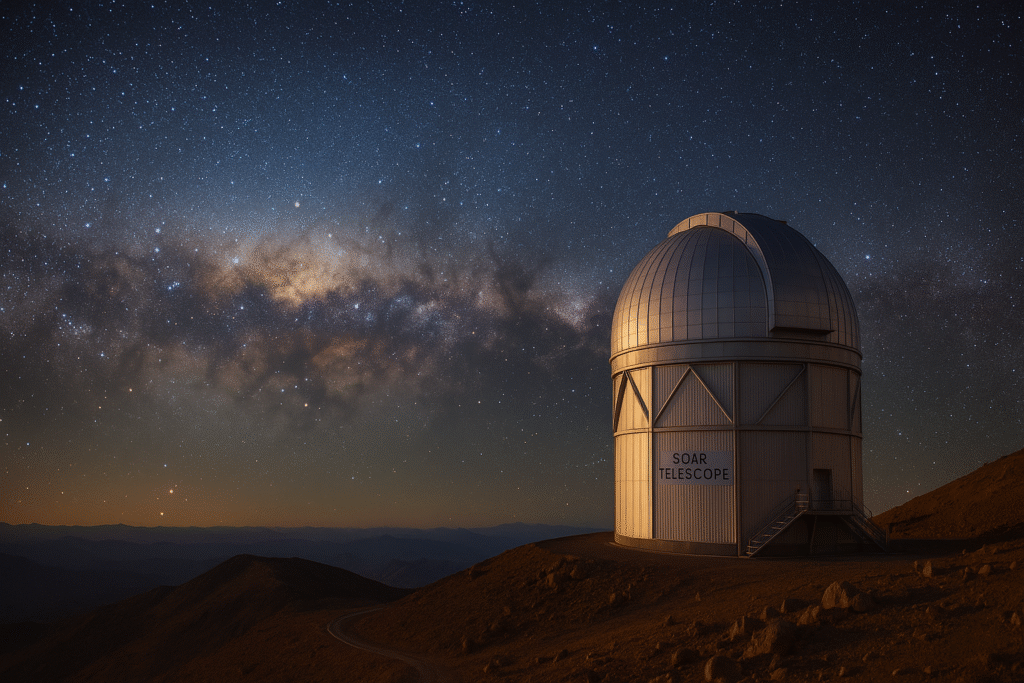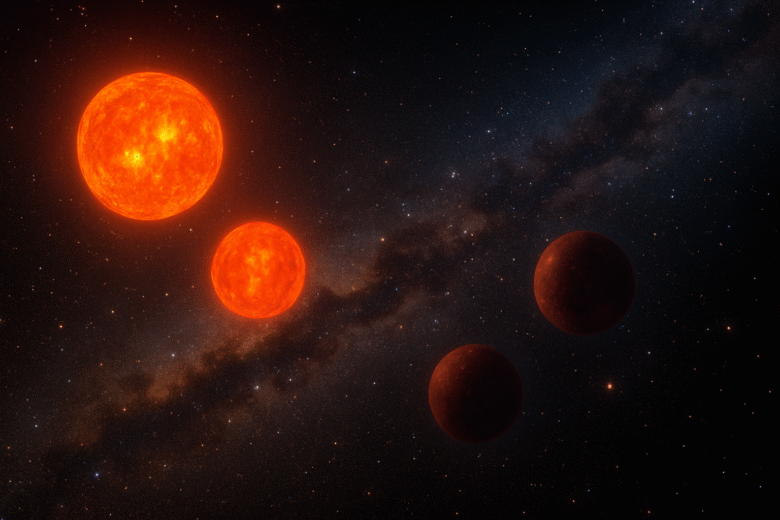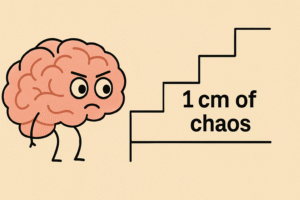Fun fact: There might be more “almost-stars” hiding near us than the bright ones we can see—some of them are forming rare quadruple systems that challenge everything we thought we knew.
Astronomers recently hit the headlines with the discovery of a quadruple star system called UPM J1040-3551 AabBab, and the title alone sounds like science fiction. What makes this system extraordinary is that it contains two pairs of brown dwarfs (sub-stellar objects that didn’t quite ignite into full stars) orbiting together with two red dwarf stars. If you’re picturing something out of Star Wars, you’re not far off. But this is real, and it’s teaching us things about the universe we didn’t know we needed to learn.
What Is UPM J1040-3551 AabBab?
The system is located about 82 light-years away in the constellation Antlia.
It comprises two binary pairs:
- Aab: Two young red dwarf stars, labelled Aa & Ab.
- Bab: Two very cool brown dwarfs, labelled Ba & Bb.
Separation and size: The two pairs are about 1,656 astronomical units (AU) apart (one AU is the Earth-Sun distance) and together they orbit a common centre of gravity over a period estimated to be more than 100,000 years.
Temperatures & brightness:
- The red dwarfs are “warm” for small stars, a few thousand Kelvins, emit visible light, though extremely faint.
- The brown dwarfs are much cooler (hundreds of Kelvins), emit mostly in the near-infrared, and are about 1,000 times dimmer than the red dwarfs in visible/infrared when you compare.
Why This Finds Its Way to “Big Deal” Status
Breaking the Age-Mass Degeneracy
Brown dwarfs are tricky because as they grow older, they cool and dim, making it hard to tell if a brown dwarf is faint because it’s old or simply less massive. When one of them is paired with regular stars whose age we can estimate (like the red dwarfs in Aab), the system becomes a benchmark. UPM J1040-3551 gives astronomers a way to calibrate models of how brown dwarfs evolve.
Testing Star & Sub-stellar Formation Theories
How do such multiple systems form? Is this a result of fragmentation in a gas cloud, or later gravitational captures, or something more exotic? Existence of stable, hierarchical quadruple systems involving brown dwarfs challenges simpler models that treat star formation as mostly single or binary events.
Revealing Hidden Populations
Many brown dwarfs are invisible in regular visible light; we see them via infrared surveys, astrometry (how things move), or via space satellites like Gaia (European Space Agency) and WISE (Wide-field Infrared Survey Explorer, NASA). Discoveries like this expose a part of the galaxy we don’t see otherwise.

Recent Related Discoveries
A brown dwarf nicknamed “The Accident”, about 50 light-years away, is among the oldest ever found (≈10-12 billion years). Its atmospheric chemistry (including the presence of silane) is unusual and helps compare youthful brown dwarfs vs. ancient ones.
Another finding: a brown dwarf called Cha Hα 1 has an unusually rich disk of gas and dust (chemical ingredients) that could support planet formation. This shows that even these “failed stars” can have the right environment for making planets.
Surveys of star-forming regions (for example, the Orion Nebula Cluster) using the James Webb Space Telescope (JWST) have found brown dwarfs with protoplanetary disks and very low masses—some as low as a few times the mass of Jupiter—bringing new data to the low-mass end of the initial mass function (IMF).
The Tools & People Behind the Discovery
Gaia (European Space Agency) helped by mapping accurate positions and motions of stars, which made it possible to see that the two pairs in UPM J1040-3551 are moving together.
WISE (NASA’s Wide-field Infrared Survey Explorer) provided infrared data to find and characterize the brown dwarfs.
SOAR Telescope at Cerro Tololo in Chile (Southern Astrophysical Research) used for spectral observations in both optical and near-infrared to confirm the nature of each component.
Key researchers: Professor Zenghua Zhang (Nanjing University), Professor Hugh Jones (University of Hertfordshire), scientists from the Brazilian National Astrophysics Laboratory, the Centre for Astrobiology (Spain), etc.
Provocative Takeaways & What This Means for Us
We’re partly blind in space. What we see in the night sky is only the brightest tip of a vast iceberg. The dimmer objects—brown dwarfs, cold companions—are doing some serious cosmic work behind the scenes.
Nature doesn’t always go for grandeur; sometimes, subtle complexity wins. Four bodies bound together in this delicate hierarchy are more than a curiosity; it’s proof that the universe can assemble surprising structures.
Imagine planets around brown dwarfs. If disks (as seen around objects like Cha Hα 1) exist, maybe some exoplanets are orbiting what we consider “failed stars.” Could life exist near brown dwarfs? Probably not in the way we imagine, but the ingredients are getting interesting.
It’s a lesson in scientific humility. Every time we capture a “first”—a first quadruple system of brown dwarfs, a first such planetary disk—it reminds us how much remains unknown.
Conclusion
The discovery of UPM J1040-3551 AabBab, a quadruple system with two red dwarfs and two brown dwarfs, is not just another fascinating astronomical find: it is a puzzle piece, a benchmark, and a challenge to what astronomers thought they had sorted out. Recent related findings, like “The Accident” and rich planet-forming disks around brown dwarfs, suggest this field is in a lively renaissance.
We’re entering an era where faint, hidden, and cold objects are becoming central to our understanding of how stars, planets, and even perhaps life itself evolve. So next time you look up at a clear sky and see only twinkling stars, remember: far more is happening out there—quietly, invisibly, and beautifully.
Author’s Note
Space is full of surprises—and the more we look, the more we find that what we call “failures” or “dim things” often tell bigger stories. UPM J1040-3551 tells us: you don’t have to shine bright to change what we believe.
G.C., Ecosociosphere contributor.
References and Further Reading
- “Rare quadruple star system could unlock mystery of brown dwarfs,” Royal Astronomical Society.
- “Astronomers Discover Extremely Rare Hierarchical Quadruple System,” News.
- “James Webb Space Telescope studies a ‘failed star’ named ‘The Accident’ to solve an old mystery of Jupiter and Saturn,” com.
- “Baby ‘failed star’ has unusually rich planet-forming disk, James Webb Space Telescope finds,” com.
- “JWST/NIRSpec Observations of Brown Dwarfs in the Orion Nebula Cluster,” arXiv.





Comments
I like what you guys are up too. Such intelligent work and reporting! Carry on the excellent works guys I have incorporated you guys to my blogroll. I think it will improve the value of my site 🙂